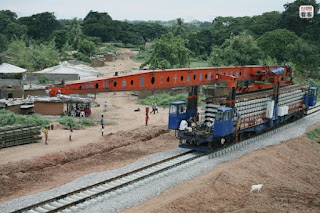Watch out for lavish development projects
 |
| Railway Lines substitutes roads transport |
This competition is opening up the purse strings as never before. Development aid is flowing to Africa in fast and furious manner. This is a good thing. It is
also risky and dangerous.
The danger is; as China takes the front seat in development of Africa, others, especially the West,”will want to catch up.” Herein lies the danger: in a bid to catch some financiers may drop their guard, funding any project that comes their way. It also some professional excited about availability of funds, could easily come up with grandiose projects.
That Africa needs huge investment
in solid infrastructure is not in doubt. The continent needs roads, railway
lines, sea ports to open up itself for trade and development. In fact, the short
cut to increased and sustainable intra-Africa trade is through transport
infrastructure.
But Africa’s agenda must be
clearly defined and strictly adhered to avoid wastage. There should be no “room for catch-up financiers.”
Those that feel left out and want to be relevant in Africa.
Development projects are fit in
three categories, either complementary, vertical progression or substitutes.
 |
| Mombasa Southern by pas: Complements Port exapnsion |
In vertical progression, the
completion of one phase leads to another. For instance, drilling of Ports to
deepen them is followed by expansion of the Port’s facilities such as terminal
to accommodate increased output. Expansion of airport termini will lead to
demand for additional runways, parking lots and taxi-ways.
Complementary projects are
projects that support the efficiency of a development project but are not
exclusively for use by the previous project. For instance a wider road serving
a sea port is complementary in that it eases traffic flow from the Port but it
also used by other motorist who perhaps have no business at the Port.
The Southern by-pass in Mombasa is
a complementary project of the Mombasa Port. But the Kipevu link road, which
originates from the Port linking it to the by-pass, is a vertical project. The
link shall be exclusively used for Port operations. Railway lines linking the
Port to the main Kenya-Uganda line are vertical projects. But the main line is
a complementary line.
It is on the basis of complementarity and
verticality or substitutability that projects should be evaluated. And it is on
this basis that questions are being voiced over the the proposed Nairobi 50Km
Nairobi double -decker road. There are conflicting reports over where the road
begins and where it will end. It is also not clear whether the road is a PPP
project or it is a public project.
Initial reports indicated that the
viaduct will begin at St. James junction near South C estate. However, other
reports indicate it shall be extended to Embakasi Junction, five Kilometres
away. Whatever the case, the road is justified on the basis of easing
congestion on the Mombasa road/Uhuru highway and the Nairobi CBD.
In addition, a Railway commuter
service is already in advanced stages of development. A contract is out for a
construction of a 5KM line and a Railway station at the JKI airport. The Major link station, the Syokimau Railway
station is already complete and is due for commissioning this week.
According to Kenya railways Officials, the
JKIA- city centre route will be served by two high speed trains each drawing
six coaches wagons. Trains have a capacity of carrying 1200 passengers on a 20-minute
trip from the Airport to the CBD.
Studies show that, the dominant
vehicle mode are cars followed by 14 seater- public service vehicles. These are
generally low density vehicles. The studies show that most motorists would
leave their cars at home if provided with a reliable and safe mode of
transport. A commuter train fits the bill.
It may never reach its design capacity at all.
Documents seen by this publication show some doubt regarding the viability of
the project. It says that the government will not charge license fees until the
project’s IRR has reached 23 per cent.
As Kenya Railways extends commuter
services to the southern suburbs of Ngong,
Rongai and adjoin areas. Traffic on Langata road will also ease. The
effect will be the same once the services are extended to the Western suburbs
of Kikuyu, Westlands and adjoining areas.
Investment in the double decker
road beats the sacrifice logic. While we
save and invest so that we can enjoy more and better goods and services in
future, the World Bank funded project does not fit the bill. We may be stuck
with a US$250 million white elephant in future.



Comments
Post a Comment